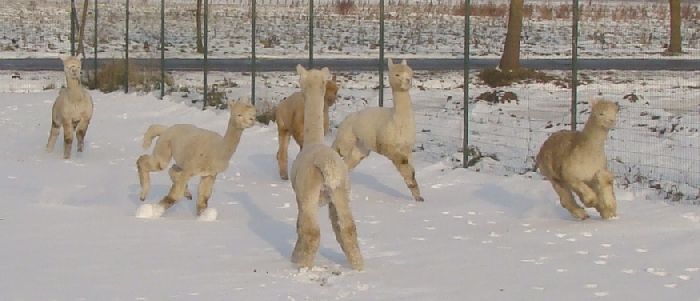De geboorte is slechts een begin
BIRTH IS BUT THE START
By Linda Blake Southern Alpacas Stud
So your cria has arrived.. What do you do next ?
Birth is but the start - there are some simple requirements to ensure you can enjoy your cria bounding around the paddock a week later.
new cria check
A quick check is advisable, even for an apparently healthy cria. Avoid handling the cria too much, and don’t touch the scent glands on the cria’s head and rump.
CRIA CHECK
Check the airway and clean out any mucus from the mouth. The cria has a filmy membrane, like a plastic wrap, on its body. Clear any membranes away from the mouth, nose, and neck, as they tighten as they dry. The rest of the membranes will come off as the cria wriggles on the ground. (The dam does not lick the cria clean.)
Ensure the ground is clean - move the cria away from dung piles. If birthing in a shed, a pile of hay or a piece of old carpet provides a clean and soft surface.
cria checkInspect the naval to make sure it is clean and that bleeding has stopped. The end of the umbilical cord should be sprayed or immersed in an antiseptic, like Betadine, to prevent infection entering the vulnerable cria. It is crucial that this is done as soon as possible.
Pop your finger in the cria’s mouth to check for bottom teeth, and to feel for a suck reflex.
The absence of these may indicate prematurity or dis-maturity (see later) .
Check for gender - two bumps underneath means one is a penis and one is the short umbilical cord stub. Lift the tail - two holes, the anus and the vulva and short clitoris below, is a female. Both male and female cria have four teats.
Weigh the cria if you think it looks small. Cria under 5 kg need intensive care after birthing.
Make sure the mother can see her baby and leave them to bond, observing from a distance.
Normal crias will be sitting up in kush position within 10 minutes. They will be standing by 3 hours old, and suckling by 4 hours old.
DAM CHECK
clearing teats of waxClear the female’s teats of wax so the milk is easier to get for the cria. A sponge moistened in warm water and warm hands to massage the udder is a nice way to do it, but practically, in the paddock, you can pull your fingers down on each teat firmly, expelling the waxy plug.
This will also tell you if the mother has milk ready, as often the milk flow does not start until the placenta has passed. The dam may keep moving away when the cria is trying to drink, until she has milk to feed it.
checking damCheck the dam for any splits or cuts from the birthing, and make sure these stay clean. Betadine ointment is a thick sticky ointment that will stay on her rear if you need to treat any such splits.
The placenta appears as a bubble of blood and should be passed within 4 to 6 hours following the birth. If the placenta is hanging out, do not pull on it - allow it to come out naturally.
placenta checkCheck that the placenta is complete when it is passed. Spread it out on the ground, handling it with gloves. Look for both sides of the uterine horns, and a smooth shape, with no pieces missing and retained in the uterus. The placenta should be taken away from the paddock, and buried.
With a late in the day birth, the placenta may not come until the following day. Call a vet if the placenta does not appear in this time frame. Oxytocin injections may be needed to get the uterine contractions necessary to expel the placenta. Oxytocin also aids milk let-down.
weighing cria
CRIA PROGRESS
Weigh the cria once it is dried off and able to stand. The usual birth weight for cria in New Zealand is about 6-9 kg, with a range from 5 to 12 kg. Cria under 5 kg need intensive care after birthing.
Monitor the progress of the cria. Weigh regularly - daily initially. Plot a chart of weights of all your cria, to notice any different growth patterns. Weigh them weekly until over 20 kg.
The weight of the cria may drop by 10% in the first couple of days, but once the milk supply is fully in, cria weight gain should be 1 to 1.5 kg a week.
Observe the feeding behaviour - how often, and if satisfactory. If a cria is seeking milk, it will find it if it is there. Usually a feeding cria will curve its tail up.
Check that the cria is getting milk - look for a milky moustache. If you are unsure, wait until it has been under mum, then put your finger in its mouth to check for milk.
Crias are active, and move and play a lot. A sluggish cria, resting more, and drinking less, not gaining weight, is of concern. Take its temperature if you have any concerns about its health. Cria should be 36.8 to 38.6 C.
The cria should be using its bowel by day 2. It will expel a browny-yellow miconium before that time. You rarely see a cria toilet, but if you see it straining at the dung heap, then it will be having difficulties.
This may well progress naturally, but you may like to try a little petroleum jelly around the anus to soften the area. Increase the fluid intake to soften the material being passed. Prune juice works ! An enema is a last resort and, in our experience, rarely works well.
Diarrhoea is a concern in cria as they can dehydrate rapidly. Keep them hydrated, using an electrolye solution, and talk to your vet.
DAMP, WET, COLD WEATHER BIRTHS
Alpacas will usually have their cria on a fine dry day, but occasionally they get caught by the weather.
A cria coat is useful for a small cria in wet and/or cold conditions outside. Place it on the ground first for mum to smell the coat. When using a cria coat, make sure it does not cover the tail area, where the scent glands are. Mum needs to be able to smell her cria there to recognise it. She will reach round and sniff there when it is feeding.
In cold, wet weather, put the cria and mother in a shed at night, or inside in a warm environment. Heat lamps help warm the air, and oil-filled electric heaters provide safer heating than electric bar heaters with hay about.
If the cria is shaking with cold, increase the warmth for the cria by snuggling it down in hay or alpaca fibre. Use plastic 2 litre milk bottles or 3 litre fruit juice bottles filled with warm water placed around it to keep it warm. Keep mum with the cria.
When housing alpacas under cover or inside, leave the light on at night, to create a day-time situation for nursing. A cria looks for milk in the darkest spot, which in a paddock is under mum. In an un-lit shed, the darkest part is the corner, and the cria will try to nurse off the wall - called a "wall baby".
LATE IN DAY BIRTH
A late in the day, or night birth, requires some extra care. Birthing late may indicate a problem.
If the sun is going, or gone, you will need to towel dry the cria. Avoid towelling the scent gland areas, on the head and at the rear of the back and around the backside.
To get cria totally dry, you can use a hair dryer. Place your hand between the air outlet and on the cria’s fleece, so you do not overheat the cria.
Put mum and cria under cover for the night. Make sure the cria drinks before you leave them. Keep the light on to create an optimal nursing situation.
It is crucial to make sure the cria gets enough to drink in those first few hours, as mum will tend to sit down to sleep, making it difficult for the cria to nurse. Check on them during the night, and get mum up for the cria to have a chance to get a drink.
EARLY MORNING BIRTHS
Very early births, just prior to or at dawn, may be a "yesterday’s baby". Do check such cria well, as often a birth that has been so delayed may have been a difficult birth due to positioning and/or size. You may recall having noticed the dam looking uncomfortable the previous day.
FRAIL NEWBORN CRIA
Any cria that looks small (5kg or under), is weak, and exhibits any signs of dis-maturity, should be closely monitored. Shorter gestation or early birth can result in premature cria. Some cria may be dysmature - full term, but not fully mature.
Signs of prematurity and dysmaturity:
Teeth not erupted through the gums
No suck reflex
Ears are floppy - they will correct in time
Cannot hold its head up
Cannot stand or straighten legs
Down on the pasterns or leg joints at odd angles - these usually self-correct over time
Toenails not fully developed - they are soft in all newborns
Most cria will wriggle and move around immediately. If the cria is lying flat, briskly rub along its spine for 30 seconds, at three minute intervals.
If you can hear noisy breathing, hold the cria upside down and tap its chest with the palm of your hand, to help loosen any fluid or mucous in the airways.
A frail cria may need towelling dry, or use a hair dryer. Bring it into a covered area to warm it up and keep it warm. Watch the cria until it stands up and has had a feed.
If the cria does not stand within 3 hours, you will need to give it some energy to keep going. Feed it 60 mls of warm water with 2 teaspoons of glucose.
Assist it to feed, by holding under the mother, or supplementary feeding initially with Anlamb. It is crucial that the cria gets colostrum within 12-24 hours of birth.
See our page on Feeding Cria.
Keep everything hygienic - infections from viruses and bacteria can rapidly be fatal to your cria.
Take its temperature, which should be from 36.8 to 38.6C. A high temperature probably indicates an infection, or, less likely in New Zealand, heat stress. A low body temperature is serious and the cria must be warmed up.
NEWBORN CRIA KIT
Items to take into the paddock
Bottle of water-based, sterile, lubrication
Gloves, both short and full arm length
Iodine- preferably at least 2.5% solution, liquid, or a spray bottle
Scales - bathroom ones, or hanging cria scales
Portable phone and vet’s phone number
Bucket and spade for placenta collection
Items if needed for extra care
Old towels and hairdryer
Cria coat
Rectangular plastic juice or milk bottles - as stable hot water bottles
Thermometer - preferably a fancy digital one that beeps when done
Antiseptic ointment like Betadine
[2009-02-23 door Linda Blake]







